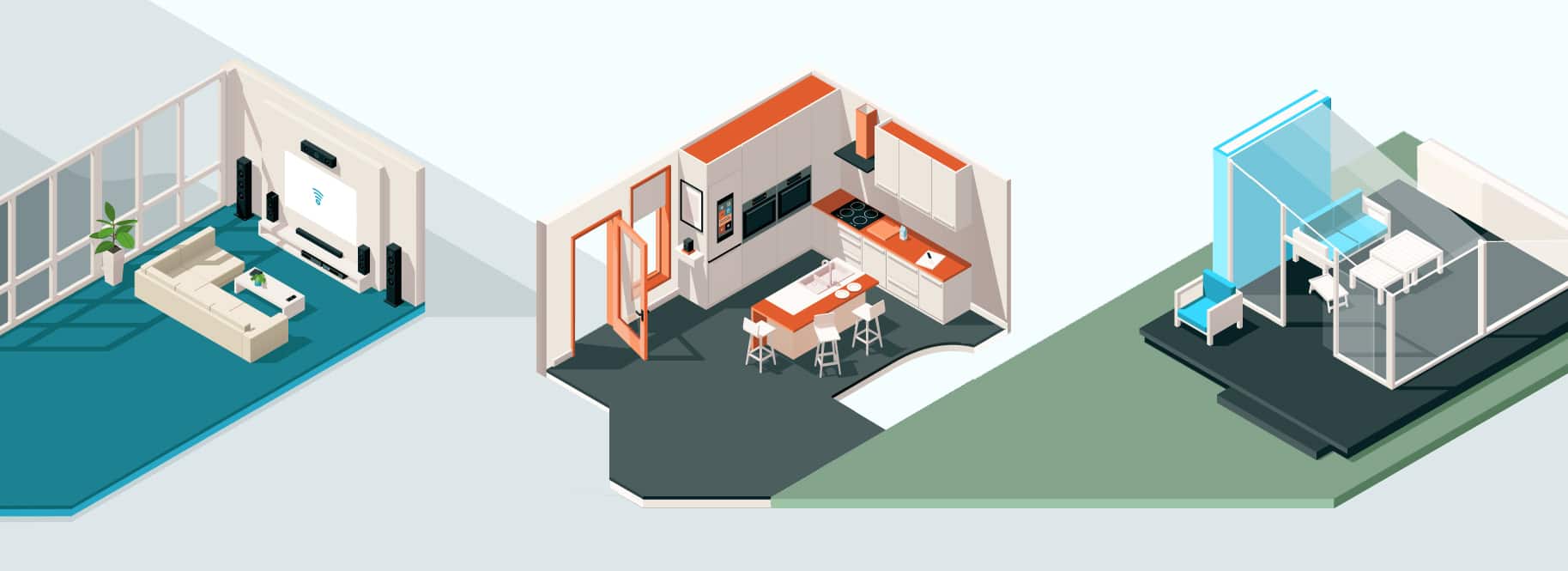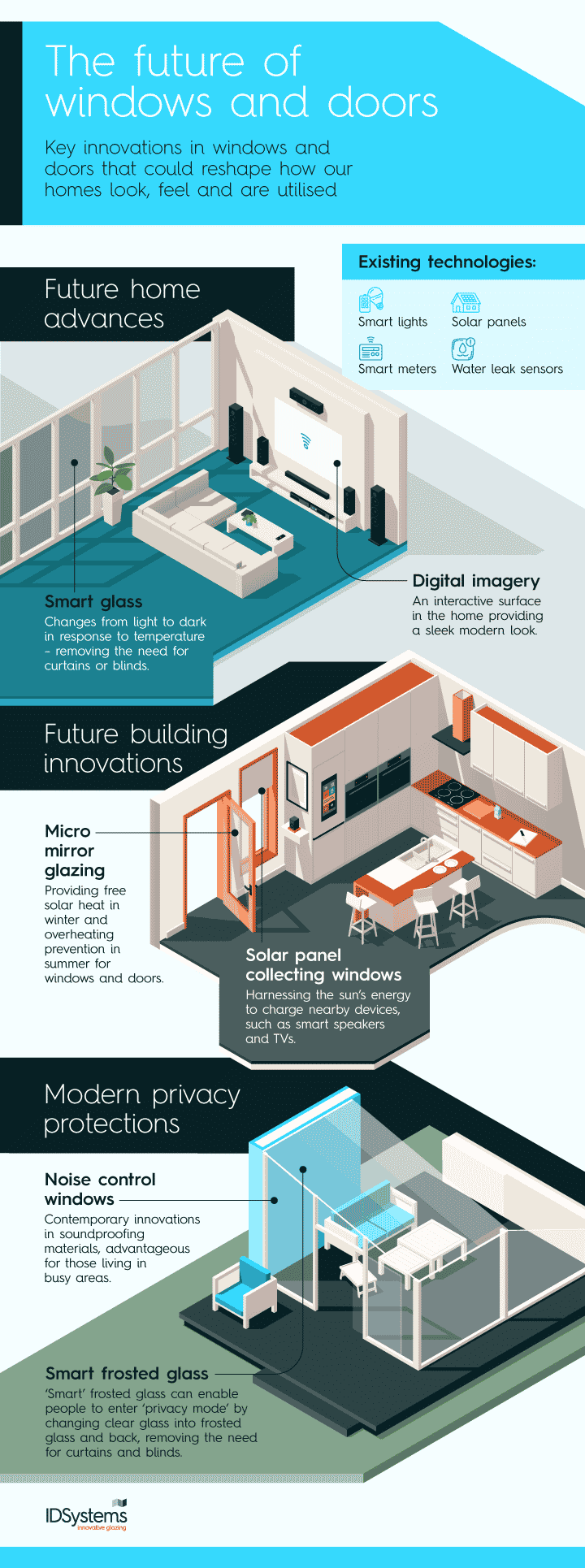
The demand for home renovations and extensions has remained high, even with the cost of living increasing. Planning authorities granted 327,600 planning decisions in the year ending March 2023 as homeowners look for new ways to maximise their usable inside space. As lifestyles change, such as a shift to homeworking or a growing family, so too does the home. Flexibility is key – and increased living costs have further underlined this fact.
In a recent survey, IDSystems asked people about their attitudes towards home renovations and the importance of keeping up with neighbours, friends or family. We found that:
But what sort of renovations and home improvements are we likely to see more of in the next decade? Keep reading to discover some of the existing, emerging and potential trends in home design and technology.
Technologies are continuing to transform our view of the ‘perfect’ home. New innovations within window and door design are already helping to drive energy efficiency and improve privacy. Our infographic highlights some impressive evolving technologies that could establish their place as home design staples in the near future.

Reality TV, documentaries, design and lifestyle magazines, and social media continue to influence how we feel about our homes and how they are perceived by others. It is therefore no surprise that 64% of our survey respondents admitted to regularly keeping tabs on renovation works happening in their local neighbourhood.
Curb appeal also remains highly significant – more than 80% stated that their homes’ aesthetic appeal (front and back) is of the utmost importance, while previous trends, such as faux Tudor style timbers, exterior pebble dash facades or white picket fences have fallen in popularity.
With up to 25% stating a desire to update their existing home design, creating light-filled spaces with contemporary finishes have become increasingly popular with new builds, home extensions and renovations, particularly when paired with open plan designs – illuminating multi-functional spaces in the home.
From modern gable-ends that offer a unique ‘wow’ factor, to sleek roof lanterns that incorporate solar control toughened glass, future trends include accessibility, minimalism and sophistication.
IDSystems’ low maintenance aluminium sliding doors, for example, combine stunning aesthetics with everyday practicality. With large panes of glass that provide the ability to create almost completely uninterrupted views out, plus the functionality to slide the doors into a pocket in the wall or away from a corner; sliding doors are a popular choice for smaller spaces or for those desiring a minimalist look. The system can incorporate a bespoke number of panels and be opened fully through the installation of a sliding corner post – subtly breaking down the barriers between inside and outside. Frameless corner windows are another modern invention that allow for panoramic views of the outside and an enhanced sense of space.
Everyday smart living technologies, such as smart lighting, water leak sensors or energy-saving heating and cooling systems, provide increased choice and flexibility for home improvements while also reducing overall energy costs. Many options are already available and are being embraced by customers.
IDSystems’ aluminium casement windows, for example, provide a high level of ventilation and energy performance. Timeless home features, such as French doors have also retained their popularity, though stylish German designed bifold doors, like SUNFLEX’s aluminium range, are a firm favourite.
Available in a variety of styles, proportions and designs, such as slender aluminium frames or with internal timber-cladding, IDSystems’ bifold door systems are some of the most thermally efficient on the market. Energy-saving U-values start from just 0.8W/m²K (based on a centre-pane of 0.5W/m2K), providing significant cost savings and meeting the requirements of even Passivhaus builds.
Combining open-plan designs with smart, energy saving technologies, future windows and doors may incorporate energy-saving technologies within traditional glazing. For example, micro mirror glazing for windows and doors could radically boost thermal efficiency performance by harnessing sunlight in the cooler months and reflecting sunlight in the warmer months – using sensors to ensure that temperatures remain optimal. Solar panel windows, which utilise the sun’s energy in the summer months and convert this to electricity, are another example of the development of glazing technology that are likely to be possible in the years to come
Colour-changing glass is an innovation that is increasingly utilised within retail and commercial spaces, such as retail kiosks, will likely transition into domestic settings as homeowners take note of its capabilities.
With the functionality to display just about any image, including your latest holiday snap, through digital imagery or switch from clear to opaque glass using electric currents, these emerging technologies could cut energy costs significantly and change the way we use the glass in our doors and windows – imagine a wall of glass that provides stunning views out during the day, but becomes a panoramic video wall to watch TV on at night.
Contemporary interior and architectural designs continue to flourish, but the desire to make the most of existing spaces and open up a home also comes with the desire to maximise privacy and security.
As consumers appreciate and understand this more, they are opting for door and window options that meet their security needs as well as their aesthetic preferences. IDSystems offers examples of how the market is already reacting to these demands. With Secured by Design specifications, which cover system design, glazing specification and locking performance, the accreditation provides peace of mind for homeowners choosing security products for their home.
Privacy glass continues to be developed. Recognising consumers’ desires to flood homes with light, future innovations will enable homeowners to enter ‘privacy’ mode at the touch of a button, without sacrificing lighting levels with the continued development of electrochromic glass. Whilst the technology that allows the glass to switch between clear and obscured is not new, developments in the future will allow for it to become more cost-effective and widely used. Frosted and patterned glass, and curtains and blinds could soon become interior trends of the past!
Noise reduction is another advantage of modern glazing innovations, keeping people’s parties private and cutting noise from passers-by, particularly in urban and built-up areas. Further development of noise cancelling coatings and glass design will provide additional options for homeowners seeking large sections of glass, such as versatile picture windows or modern balustrades and balconies on homes within bustling towns or cities.
If you’re considering a home renovation or want to build your own home, we have plenty of inspiration. Check out how IDSystems’ cutting-edge windows and doors have been utilised by our customers in our range of case studies.